Upgrading the SSD in Chromebook & MyDigitalSSD Super Boot Drive M.2 2242 SSD Review
by Kristian Vättö on October 21, 2014 8:00 AM ESTRandom Read/Write Speed
The four corners of SSD performance are as follows: random read, random write, sequential read and sequential write speed. Random accesses are generally small in size, while sequential accesses tend to be larger and thus we have the four Iometer tests we use in all of our reviews.
Our first test writes 4KB in a completely random pattern over an 8GB space of the drive to simulate the sort of random access that you'd see on an OS drive (even this is more stressful than a normal desktop user would see). We perform three concurrent IOs and run the test for 3 minutes. The results reported are in average MB/s over the entire time.
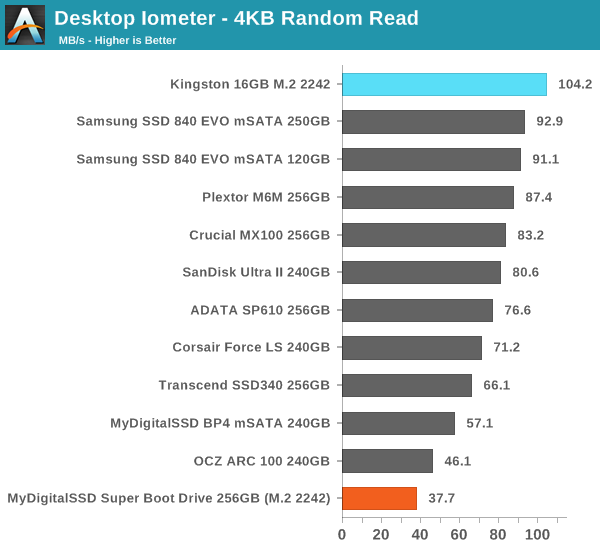
Surprisingly the 16GB Kingston M.2 drive has excellent random read performance. I suspect that having such little NAND helps with random read performance because you are practically hitting the same LBAs, so some IOs may be cached and there is less tracking overhead as well. The MyDigitalSSD drive, on the other hand, does not fare that well, although random read performance has never been the biggest strength of Phison controllers in my experience.

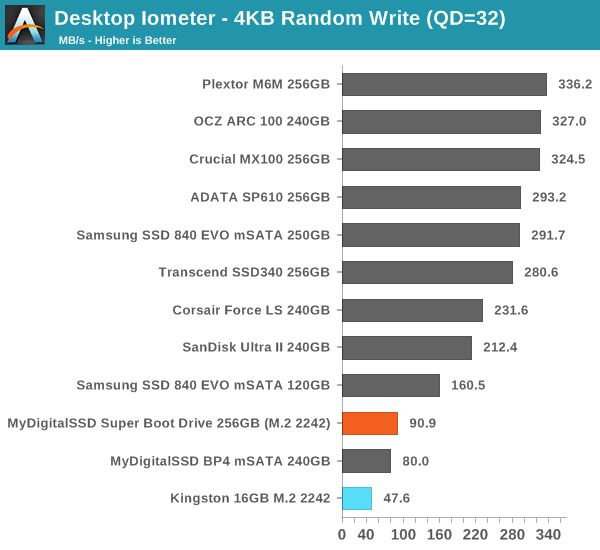
Both the MyDigitalSSD and Kingston drives have rather poor random write performance. Since neither of the drives have a DRAM cache, the host IOs along with the NAND mapping table need to be cached in the internal cache of the controller (or alternatively in NAND), which adds limitations since the internal SRAM caches are typically only a few megabytes in size and NAND is much slower than DRAM.
Sequential Read/Write Speed
To measure sequential performance we run a 1 minute long 128KB sequential test over the entire span of the drive at a queue depth of 1. The results reported are in average MB/s over the entire test length.
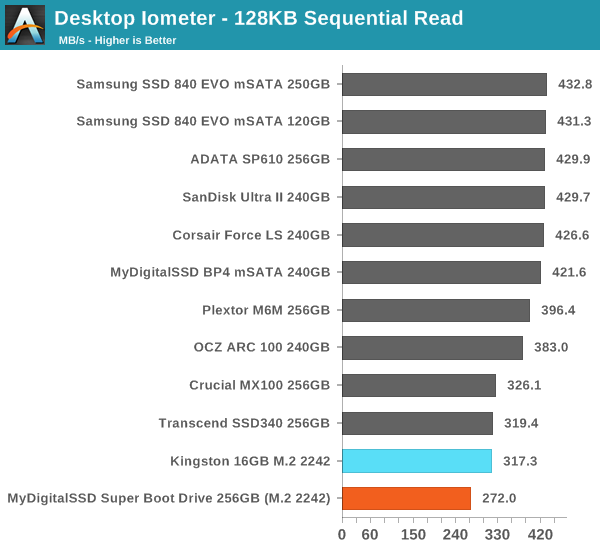
Sequential read is also better on the 16GB Kingston drive, so it seems that the additional NAND adds quite a lot of overhead when there is no DRAM for caching purposes. In write speed the MyDigitalSSD drive is considerably faster, although 2.5" 256GB drives are also substantially faster still.
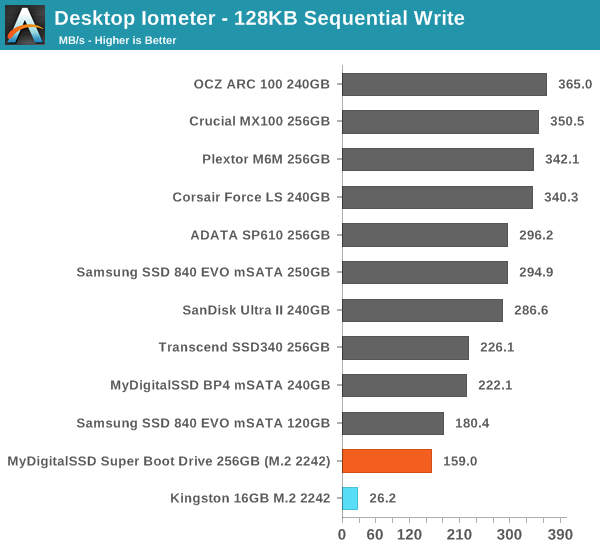
AS-SSD Incompressible Sequential Read/Write Performance
The AS-SSD sequential benchmark uses incompressible data for all of its transfers. The result is a pretty big reduction in sequential write speed on SandForce based controllers, but most other controllers are unaffected.
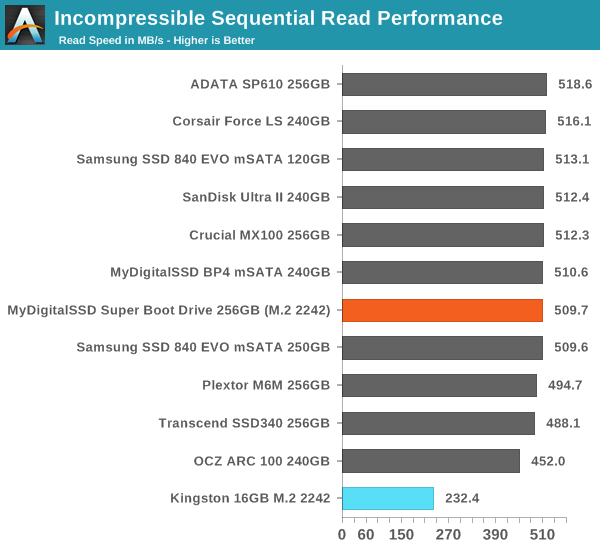











67 Comments
View All Comments
pSupaNova - Wednesday, October 22, 2014 - link
No he is correct, Microsoft did not want netbooks to succeed.While Intel tried to Gimp their graphics and even stopped Nvidia ION project from improving the graphics situation
This mistake let tablets have an easier ride and now Nvidia has a remarkable SOC in the K1 thats going to eat Intel alive in the coming years.
jabber - Wednesday, October 22, 2014 - link
Netbooks were awful. They deserved to die. I ended up refusing to fix or work on them for customers. They would bring them to me saying "this is slow!" I would reply "It's because it IS slow!"Poor user experience and a waste of money. A novelty that should never have survived longer than a few months.
mike8675309 - Tuesday, October 21, 2014 - link
There were two specific problems. #1 - slow hard drives. #2 - no hardware video acceleration. With the Atom chip and slow drives with no hardware video acceleration, you have what is sitting in my basement and is effectively useless.hojnikb - Tuesday, October 21, 2014 - link
And its pretty much possible to make one for 150-200$, since windows licenses are free with cheap devices and Intel tablet SoC are selling for peanuts.Eeebook x205 is an example of that.
inmytaxi@gmail.com - Sunday, November 2, 2014 - link
The 10 inch laptop form factor is dead for windows, replaced by 10 - 11.6 inch tablets many with removable or flip-able keyboards.sligett - Tuesday, October 21, 2014 - link
All my users of HP 3105m netbooks (with AMD e-350 processors, and SSD or HDD) chose to move to Chromebooks when they were offered to them. In the schools where I work, a Windows laptop would have to be LESS expensive than a Chromebook to be attractive. In fact, a $200 Chromebook is in many ways more appealing than a free Windows laptop.RU482 - Tuesday, October 21, 2014 - link
My 12yr old daughter would object to your statement about AMD Brazos. I'll agree, when I bought the Lenovo Netbook that had the E-350 CPU for my traveling notebook/netbook, it was miles ahead of the Atom Z520 based Asus netbook that it replaced.Fast forward to 2014, the Lenovo has been handed down to my daughter, who likes to watch Netflix or play flash games on it. She's recently started to complain about how laggy the Lenovo has become. SSD health and free space are still good, wifi signal strength 5 bars....not sure what the excuse is, maybe she's used mom's i5 Haswell laptop too much! I'd say it's time to retire the Lenovo Brazos machine
Michael Bay - Wednesday, October 22, 2014 - link
In any netbook article one can expect a couple of sad AMD fanatics with drivel like that.Wake up, Brazos was hot as all hell and didn`t deliver anything Atom couldn`t.
waldojim42 - Thursday, October 23, 2014 - link
Yes, they most certainly did. Video acceleration and useful CPU performance. AMD made netbook CPU's that had significantly higher IPC at a cost of higher power usage.savagemike - Tuesday, October 21, 2014 - link
It's pretty easy to dual or co-boot linux on a Chromebook, and honestly that would be about the only good reason to upgrade storage to this kind of capacity. It would, of course, provide a whole host of tools/programs which would address some of the drawbacks you mention.That makes sense as desktop Linux, like Windows or OSX, are designed for a traditional local storage centric paradigm, where the ChromeOS devices of course are not.
The one true fault of the ChromeOS file explorer within its own context is the lack of local network integration. You really should be able to see/use shares on a LAN from the files app on a ChromeOS device and you can't.